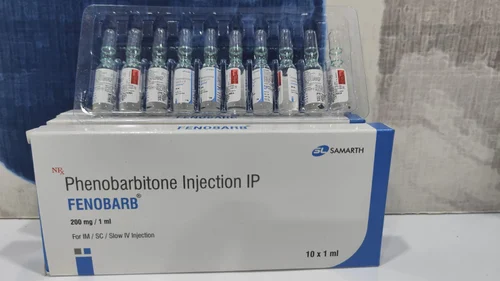💉 Phenobarbitone Injection 200 mg/mL
📌 1. Prescription / Indications:
Phenobarbitone Injection is prescribed for:
- Status epilepticus
- Neonatal seizures
- Severe generalized tonic-clonic seizures
- Sedation in emergency settings
- Preoperative sedation
- Used when oral administration is not feasible
📄 2. Description:
- Form: Injectable solution
- Strength: 200 mg of Phenobarbitone per 1 mL
- Route: Intravenous (IV) or Intramuscular (IM)
- Appearance: Clear to slightly yellow sterile solution
- pH: Alkaline (requires cautious administration)
🔬 3. Nature / Drug Class:
- Class: Barbiturate (long-acting)
- Type: CNS depressant, anticonvulsant
- Mechanism of Action: Enhances GABAergic neurotransmission; decreases excitatory nerve activity
🌟 4. Advantages:
- Rapid control of seizures in emergencies
- Effective in neonatal and pediatric seizure control
- Long duration of action allows less frequent dosing
- Suitable for patients unable to take oral medications
📦 5. Common Packaging:
| Packaging | Details |
|---|
| Ampoules or vials | 1 mL or 2 mL per unit |
| Multi-dose vials | Available in hospital settings |
| Amber glass | Protects from light |
🧊 6. Storage Conditions:
- Store below 25°C (77°F)
- Protect from light and freezing
- Use with aseptic technique
- Discard unused solution within recommended period after opening
👩⚕️ 7. Patient Advice / Monitoring:
- Used under close medical supervision
- May cause:
- Drowsiness
- Respiratory depression
- Hypotension (especially with IV use)
- Do not self-administer
- Inform healthcare provider about other medications or allergies
- Continuous monitoring (especially in neonates or status epilepticus)
🎯 8. Purpose / Clinical Use:
| Condition | Use |
|---|
| Status epilepticus | Emergency control (loading dose) |
| Neonatal seizures | First-line parenteral therapy |
| Acute seizure episodes | When oral route unavailable |
| Pre-anesthesia sedation | Occasionally used |
⚠️ 9. Precautions / Warnings:
- Give IV slowly to avoid respiratory or cardiovascular depression
- Avoid extravasation – alkaline solution can cause tissue injury
- Caution in:
- Liver dysfunction
- Renal impairment
- Elderly or debilitated patients
- Interactions: Induces CYP enzymes, affecting metabolism of many drugs
- Pregnancy Category D – risk of fetal harm, use only if necessary

